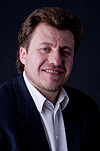|
Wednesday, Jan. 9
- Breakfast: breakfast strata
- Harvest moon vegetable soup
- Carolina chopped-pork sandwich
- Chicken curry
- Smart cuisine: ancho chili barbecue beef
- Italian antipasto sandwich
- Assorted calzones
- Mumbo jumbo baked potatoes
Wilson Hall Cafe Menu |
|
Wednesday, Jan. 9
Lunch
- Northern Italian lasagna
- Caesar salad
- Cannolis
Friday, Jan. 11
Dinner
Guest chefs: Grace and Gary Leonard
- Pear, blue cheese and walnut salad
- Cocoa crusted pork tenderloin
- Potato cakes
- Haricots verts
- Blueberry upside-down cake with cream chantilly
Chez Leon Menu
Call x3524 to make your reservation.
|
|
Explain it in 60 seconds: bosons
 |
All particles fall into one of two classes, bosons or fermions. Two bosons with identical properties can be in the same place at the same time, but two fermions cannot. Image: Sandbox Studio |
There are two kinds of elementary particles in the universe: bosons and fermions. Bosons don't mind sitting on top of each other, sharing the same space. In principle, you could pile an infinite number of bosons into the tiniest bucket. Fermions, on the other hand, don't share space: only a limited number of fermions would fit into the bucket.
Matter, as you might guess, is made of fermions, which stack to form three-dimensional structures. The force fields that bind fermions to each other are made of bosons. Bosons are the glue holding matter together.
Bosons and fermions act like two different kinds of spinning tops. Even when a boson or fermion is by itself, it always has an intrinsic angular momentum, which scientists call spin. Bosons always have an integer amount of spin (0, 1, 2…), while fermions have half-integer spin (1/2, 3/2, 5/2…).
Before July 2012, every fundamental particle that physicists had discovered had non-zero spin. But the theory behind the Higgs boson predicts that it should have no spin. If the early indications hold up and the new particle discovered at the Large Hadron Collider really is the Higgs boson, it will be the first known example of an elementary particle that knows no direction and no polarization—a truly revolutionary discovery.
—Sean Carroll, California Institute of Technology
Read similar explanations in the symmetry archive
|
Purdue University Calumet
NAME:
Purdue University Calumet
HOME TOWN:
Hammond, Ind.
MASCOT:
Peregrine
COLORS:
Black and gold
COLLABORATING AT FERMILAB SINCE:
2005
WORLDWIDE PARTICLE PHYSICS COLLABORATIONS:
CMS, DZero
NUMBER OF SCIENTISTS AND STUDENTS INVOLVED:
One faculty, one postdoc, two undergraduates
PARTICLE PHYSICS RESEARCH FOCUS:
The Purdue Calumet group has been responsible for critical tasks on the CMS forward pixel detector—developing its geometry, performing burn-in tests for all modules and writing the geometry for the upgrade option. We have performed physics analysis on CMS data in the electroweak sector on the W-muon asymmtery and physics beyond the Standard Model in the search for the W prime boson. Additionally, we are responsible for co-coordinating tracker DQM shifts at Fermilab's ROC.
WHAT SETS PARTICLE PHYSICS AT PURDUE CALUMET APART?
Purdue Calumet is the only undergraduate and teaching institution in the US CMS list of collaborating institutions and the only high-energy physics institution in Northwest Indiana with official membership in Fermilab and CERN experiments. The group has primarily supported women and minorities, with a very heavy component on both building the CMS pixel detector and developing the geometry software for the current detector and the upgrade. Our education outreach activities have been recognized by the Fermilab director. The group is working on establishing a QuarkNet center at the university. Proximity to Fermilab has been a great advantage. Purdue Calumet's undergraduate students have led the CMS tracker validation effort.
FUNDING AGENCIES:
NSF
View all university profiles.
|
Astronomy: Dwarf galaxies found orbiting Andromeda confound scientists
From Alaska Dispatch, Jan. 4, 2013
Thirteen dwarf galaxies are playing a cosmic-scale game of Ring Around Andromeda, forming an enormous structure astronomers have never seen before and are hard-pressed to explain with current theories of how galaxies form and evolve.
Read more |
|
An outstanding paper
 |
|
Vladimir Shiltsev
|
Vladimir Shiltsev, director of the Accelerator Physics Center, wrote this column.
Right before Christmas, the editors of Physical Review Special Topics - Accelerators and Beams announced their annual list of outstanding PRST-AB articles from 2011. The list is based on the number of citations articles received in 2012 and the opinions of the two dozen internationally acclaimed experts in beam physics who serve on the PRST-AB editorial board.
One of the outstanding papers comes from Fermilab's Yin-E Sun and Philippe Piot, who holds a joint appointment with Fermilab and Northern Illinois University. Together with collaborators from Argonne and NIU, they published a paper on a novel, practical method to tailor the current profile of a particle beam to follow, in principle, any desired distribution. (A year ago, the editors picked another paper that included a Fermilab author—Sergei Nagaitsev—as one of the outstanding papers.)
Sun and Piot's idea is based on a technique pioneered and experimentally demonstrated at Fermilab several years ago: transverse-to-longitudinal phase space exchange. The authors foresee unique opportunities to generate trains of microbunches with tunable spacing and linearly ramped current profiles, which is so much desired for future wakefield accelerators. It is one of the techniques that could be tested experimentally at the proposed Advanced Superconducting Test Accelerator facility at Fermilab.
|
ESH&Q weekly report, Jan. 8
This week's safety report, compiled by the Fermilab ESH&Q section, contains five incidents.
Two separate employees showed a standard threshold shift in their hearing (previously pending-claim cases). Both cases have been determined to be work-related.
An employee strained his back while repositioning a section of fence. He received first-aid treatment.
An employee reported feeling occasional discomfort in his wrist while using his keyboard.
An employee slipped and fell on the sidewalk. The claim is pending.
Find the full report here. |
Viewpoint: Mixed feelings about a rare event
From Physics, Jan. 7, 2013
One of the most important missions of the Large Hadron Collider at CERN is to search for phenomena that cannot be explained by the standard model of particle physics. In this context, the latest result from the LHCb experiment, now reported in Physical Review Letters, is a bittersweet victory. The LHCb collaboration has, for the first time, observed evidence for the very rare decay of a neutral meson into a pair of muons. Only about one in every 300 million of the meson's decays happen this way, and it is no small feat that LHCb has been able to detect the few that do. The rate at which the decay occurs also agrees with the value calculated using the standard model, a theoretical success considering the intricacies involved in the calculations. But many particle physicists were hopeful that the agreement between theory and experiment wouldn't be quite so good, since a deviation would have been a sign that new physics was at play. So far, no such signs are there, but in the future, the precision of the measurement will improve considerably, potentially allowing smaller deviations from the standard model predictions to be detected.
Read more |
|